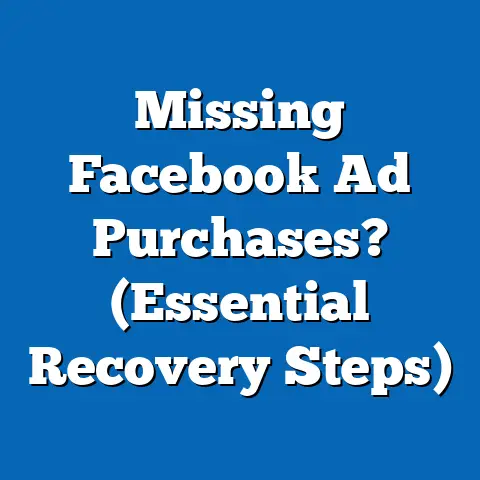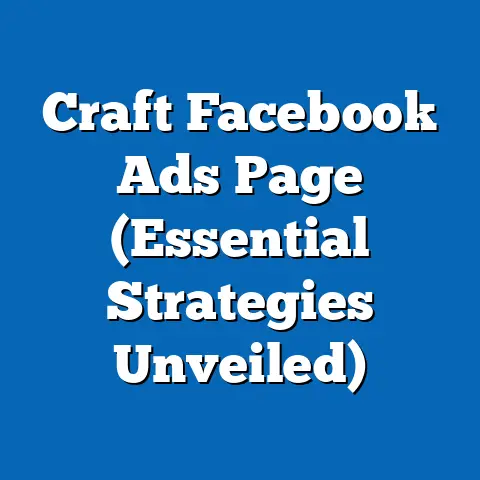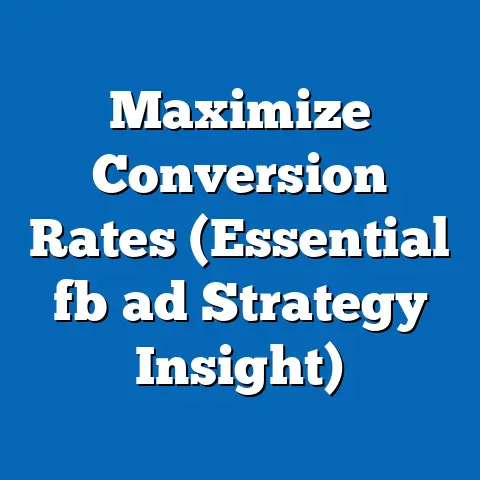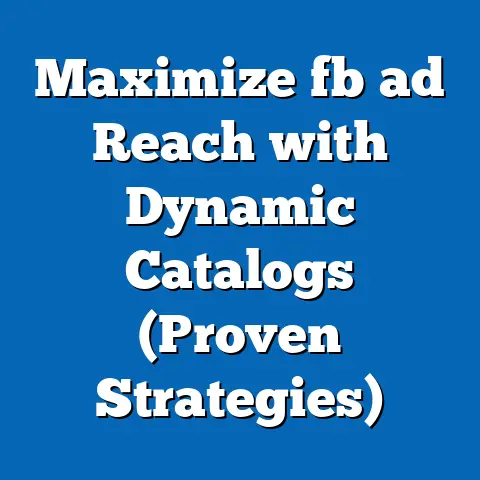Target Students with Facebook Ads (Proven Strategies Revealed)
Before the advent of social media advertising, reaching student demographics was a cumbersome and often imprecise endeavor. Imagine a university campus in the early 2000s, where marketers relied on physical flyers pinned to bulletin boards, local radio ads, or campus newspaper placements to promote products or services. These methods were not only resource-intensive but also lacked the ability to target specific student interests, behaviors, or needs, often resulting in low engagement and wasted budgets.
Fast forward to the present day, and the landscape has transformed dramatically. With platforms like Facebook, marketers can now pinpoint students based on age, location, academic interests, and even real-time behaviors—such as joining university groups or engaging with campus events online. This precision, powered by data analytics and algorithmic targeting, has revolutionized how brands connect with students, yielding higher engagement rates and more cost-effective campaigns.
Section 1: Understanding the Student Demographic
1.1 Defining the Student Demographic
Students, typically aged 18-24 for traditional college attendees, represent a dynamic and diverse demographic with distinct characteristics. They are often in a transitional life stage, balancing education with emerging independence, which shapes their purchasing behaviors and media consumption habits. While this group includes high school, undergraduate, and graduate students, the focus here is primarily on college-aged individuals, a key target for many marketers due to their potential lifetime customer value.
Students are not a monolith; they vary widely by socioeconomic background, cultural context, and academic focus. However, common traits include a high adoption of technology, a preference for value-driven purchases due to limited budgets, and a strong influence from peer networks and social trends. Understanding these nuances is critical for crafting effective Facebook ad campaigns.
1.2 Historical Context of Marketing to Students
Marketing to students has evolved significantly over the past century. In the mid-20th century, the post-war economic boom and the GI Bill in the United States led to a surge in college enrollment, creating a recognizable “student market.” Brands began targeting this group through campus-specific channels like student unions and dormitories, often with promotions for affordable goods like textbooks or clothing.
By the 1980s and 1990s, the rise of MTV and other youth-oriented media provided new avenues to reach students, focusing on lifestyle and entertainment. However, these methods lacked precision, often casting a wide net with little insight into individual preferences. The advent of the internet in the late 1990s and early 2000s marked the first major shift toward digital marketing, though early efforts were rudimentary compared to today’s capabilities.
1.3 Societal Implications of Targeting Students
Students are often early adopters of trends and technologies, making them a bellwether for broader cultural shifts. Targeting them effectively through platforms like Facebook not only influences their immediate behaviors but also shapes long-term brand loyalty as they transition into higher-earning life stages. However, this also raises ethical concerns about data privacy, as students may be less aware of how their online activities are tracked and used for commercial purposes.
Moreover, the hyper-targeted nature of digital ads can contribute to echo chambers, where students are exposed primarily to content that reinforces their existing interests or biases. This has implications for their worldview and decision-making processes, highlighting the need for responsible advertising practices. As we explore Facebook ad strategies, these societal dimensions remain a critical backdrop.
Section 2: The Rise of Facebook as a Marketing Powerhouse for Students
2.1 Why Facebook Remains Relevant for Student Targeting
Despite the rise of platforms like TikTok and Instagram, Facebook continues to be a powerful tool for reaching students. As of 2023, Facebook boasts over 2.9 billion monthly active users globally, with a significant portion in the 18-24 age bracket, according to Statista. Its robust advertising platform, coupled with integration across Meta’s ecosystem (including Instagram), allows for unparalleled targeting precision.
Facebook’s appeal to students lies in its versatility. It serves as a hub for university groups, event planning, and peer-to-peer communication, making it a natural space for organic and paid engagement. Additionally, students often use the platform to stay connected with family and broader networks, ensuring consistent usage even as newer platforms gain traction.
2.2 Technological Factors Driving Facebook’s Effectiveness
The backbone of Facebook’s advertising success is its data collection and machine learning algorithms. Marketers can target students based on demographics (age, location), interests (academic majors, hobbies), behaviors (event attendance, app usage), and even life events (starting college, graduation). The platform’s Lookalike Audiences feature further amplifies reach by identifying users similar to existing student customers.
Moreover, Facebook’s ad formats—such as carousel ads, video ads, and Stories—cater to students’ preference for visually engaging, mobile-first content. With over 90% of students accessing social media via smartphones (Pew Research Center, 2022), mobile-optimized campaigns on Facebook are non-negotiable. These technological advancements have made it possible to move beyond the scattershot approaches of the past to highly personalized interactions.
2.3 Cultural Shifts and Student Engagement on Facebook
Culturally, students today are digital natives, having grown up with social media as a constant presence. This familiarity breeds both opportunity and skepticism; while they are receptive to online ads, they also value authenticity and are quick to reject overt commercialism. Campaigns that resonate often align with student values, such as sustainability, inclusivity, or affordability.
Additionally, the role of peer influence cannot be overstated. Students are more likely to engage with ads shared or endorsed by friends, a dynamic Facebook leverages through social proof mechanisms like likes, comments, and shares. Understanding these cultural undercurrents is key to crafting ads that feel less like interruptions and more like relevant conversations.
Section 3: Proven Strategies for Targeting Students with Facebook Ads
3.1 Strategy 1: Hyper-Targeted Audience Segmentation
One of the most effective ways to reach students is through detailed audience segmentation using Facebook’s Ads Manager. Start by defining your target based on location (e.g., near specific universities), age (18-24), and interests (e.g., “college life,” “student discounts”). Layer this with behavioral data, such as engagement with campus events or membership in student organizations.
For example, a company selling affordable laptops could target students in STEM programs by selecting interests like “engineering” or “computer science.” Case studies show that hyper-targeted campaigns can achieve click-through rates (CTR) up to 2.5 times higher than broad campaigns (WordStream, 2023). The key is to continuously refine audiences based on ad performance data to ensure relevance.
3.2 Strategy 2: Leverage Student-Friendly Ad Content
Content is king when targeting students, who are bombarded with information daily. Ads must be concise, visually striking, and value-driven. Video ads, in particular, perform well, with 65% of Gen Z and Millennials (overlapping with student demographics) reporting they watch online videos daily (HubSpot, 2022).
Consider a campaign for a meal delivery service. A short video ad showcasing quick, budget-friendly meals with a clear call-to-action (CTA) like “Get 20% Off Your First Order” can drive engagement. Incorporating user-generated content (UGC), such as student testimonials, further builds trust and relatability, as peers are seen as credible sources.
3.3 Strategy 3: Utilize Seasonal and Event-Based Campaigns
Students’ lives are often dictated by academic calendars, making seasonal targeting a powerful tool. Back-to-school campaigns in late summer, mid-term stress-relief promotions, or graduation-focused ads in spring can align with students’ immediate needs. For instance, a study by eMarketer (2022) found that back-to-school campaigns on social media see a 30% uptick in engagement among 18-24-year-olds.
Facebook Events can also be leveraged to target students attending specific campus happenings. A local coffee shop might create an ad for a “study session discount” tied to a university’s finals week, ensuring the message resonates with the audience’s current context. Timing and relevance are critical to capturing attention amidst competing distractions.
3.4 Strategy 4: Offer Incentives and Discounts
Given students’ budget constraints, incentives like discounts, free trials, or exclusive offers are highly effective. Facebook’s dynamic ads allow for personalized promotions—showing a student a 10% off code for a product they’ve previously viewed on a website. Data from RetailMeNot (2023) indicates that 80% of students are more likely to make a purchase when a discount is offered.
Beyond direct savings, gamification—such as entering a contest for a chance to win free products—can boost engagement. A clothing brand might run a “Tag a Friend to Win a Semester Wardrobe” campaign, leveraging students’ social networks for viral reach. These strategies tap into both financial and social motivators.
3.5 Strategy 5: Optimize for Mobile and Test Continuously
Since students predominantly access Facebook via mobile devices, ads must be optimized for smaller screens with fast-loading visuals and clear CTAs. Vertical formats, like Stories, often outperform traditional formats, with a 20% higher completion rate for video ads (Facebook Business, 2023). Ensuring seamless navigation to landing pages is equally important to avoid drop-off.
A/B testing is another cornerstone of success. Test different ad creatives, copy, and audience segments to identify what resonates most. For instance, a tutoring service might test an ad highlighting “Ace Your Finals” versus “Affordable Tutoring Now” to see which drives more clicks. Continuous optimization based on data ensures campaigns remain effective over time.
Section 4: Comparative Analysis Across Generations
4.1 Students as Part of Gen Z and Millennials
Most current students fall into Gen Z (born 1997-2012), with some older students in the Millennial cohort (born 1981-1996). While both generations are tech-savvy, Gen Z students are true digital natives, often prioritizing platforms like TikTok for entertainment but still using Facebook for community and events. Millennials, on the other hand, may have more disposable income as graduate students or non-traditional learners, influencing their response to ads.
Gen Z students tend to value authenticity and social impact, responding well to brands that align with causes like climate change or diversity. Millennials, having experienced the 2008 financial crisis, often seek practicality and long-term value in purchases. Tailoring ad messaging to these generational nuances—while avoiding stereotypes—is essential for effectiveness.
4.2 Contrasting with Older Demographics
Compared to older generations like Gen X or Baby Boomers, students are more receptive to digital ads but also more discerning. While Boomers might trust traditional advertising channels, students rely heavily on social proof and peer recommendations, a dynamic Facebook excels at facilitating. Additionally, students’ shorter attention spans necessitate quicker, punchier ad formats than what might work for older audiences.
Economic factors also play a role. Unlike Gen X, who often have established careers, students’ limited budgets make cost-saving offers more appealing. However, their openness to new experiences can drive higher trial rates for innovative products compared to more cautious older demographics. Marketers must balance these factors when designing cross-generational campaigns.
Section 5: Societal and Ethical Implications
5.1 Privacy Concerns in Student Targeting
Facebook’s ability to collect vast amounts of data on students raises significant privacy concerns. Many students are unaware of how their likes, shares, and group memberships are used to build detailed profiles for ad targeting. A 2022 survey by the Pew Research Center found that 70% of young adults feel uneasy about the amount of personal information social media platforms hold.
This unease is compounded by high-profile data scandals, such as the Cambridge Analytica incident, which highlighted the potential misuse of user data. Marketers must prioritize transparency, clearly communicating how data is used and offering opt-out options. Ethical advertising practices not only build trust but also mitigate the risk of regulatory backlash as privacy laws evolve.
5.2 Impact on Student Behavior and Culture
Targeted ads influence more than just purchasing decisions; they shape how students perceive needs and aspirations. Constant exposure to promotions for lifestyle products or academic tools can create pressure to conform to certain standards, contributing to financial stress or social comparison. Conversely, well-crafted campaigns can empower students by connecting them with resources like affordable housing or mental health services.
Culturally, the normalization of targeted advertising reinforces a consumerist mindset among students, potentially overshadowing non-commercial values. Brands have a responsibility to balance profit motives with social good, perhaps by supporting student causes or promoting sustainable practices. The long-term impact on student culture remains an area for further research.
5.3 Workplace and Economic Implications
For businesses, effectively targeting students on Facebook can drive early brand loyalty, a valuable asset as students enter the workforce with greater purchasing power. Companies in sectors like technology, education, and retail stand to gain significantly by establishing themselves as trusted names during students’ formative years. However, overzealous targeting risks alienating this demographic if perceived as intrusive.
Economically, the student market represents a growing segment, with global spending by college students estimated at over $500 billion annually (IBISWorld, 2023). Harnessing this potential through platforms like Facebook can stimulate innovation in products tailored to student needs, from budget-friendly tech to flexible subscription services. Yet, economic disparities among students must be considered to avoid exclusionary practices.
Section 6: Case Studies and Real-World Examples
6.1 Case Study 1: Spotify’s Student Discount Campaign
Spotify has mastered targeting students through Facebook ads by offering a discounted Premium plan for verified college students. Their campaigns use vibrant visuals and relatable copy like “Soundtrack Your Study Sessions,” often targeting specific universities or academic interests. By integrating social sharing features, Spotify encourages students to spread the word, amplifying organic reach.
The result? Spotify reported a 30% increase in student subscriptions year-over-year after launching targeted Facebook campaigns (Spotify Investor Report, 2022). This success underscores the power of combining value-driven offers with precise audience segmentation and engaging content.
6.2 Case Study 2: Local Business Boost During Back-to-School
A small bookstore near a major university used Facebook ads to promote back-to-school deals on textbooks and supplies. By targeting students within a 10-mile radius of the campus and using event-based triggers (e.g., start of the semester), they achieved a 40% uptick in foot traffic during the campaign period. Dynamic ads showcasing real-time inventory further drove conversions.
This example highlights how even small businesses can leverage Facebook’s tools to compete with larger players. The key was aligning the campaign with students’ immediate needs and ensuring a seamless online-to-offline experience.
Section 7: Conclusion and Forward-Looking Insights
The transformation from traditional to digital marketing, epitomized by Facebook’s advertising capabilities, has redefined how brands connect with students. Through hyper-targeted segmentation, student-friendly content, seasonal campaigns, incentives, and mobile optimization, marketers can achieve unprecedented engagement with this demographic. Yet, the strategies outlined here are not static; they must evolve with technological advancements and shifting student behaviors.
Looking ahead, the role of emerging technologies like artificial intelligence and augmented reality in Facebook ads holds promise for even more immersive student experiences. However, uncertainties remain, particularly around privacy regulations and platform saturation as newer apps vie for attention. Marketers must stay agile, balancing innovation with ethical considerations to maintain trust.
Ultimately, targeting students with Facebook ads is both an opportunity and a responsibility. Done well, it fosters meaningful connections that benefit both brands and students. Done poorly, it risks alienating a generation that values authenticity above all. As we navigate this digital frontier, the focus must remain on creating value—both for the bottom line and for the broader societal good.






